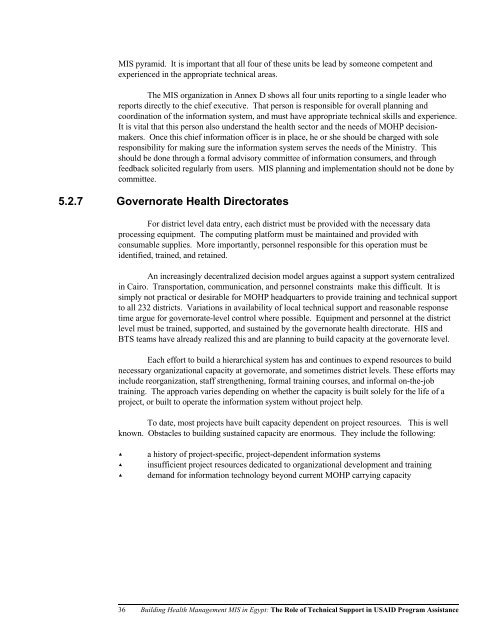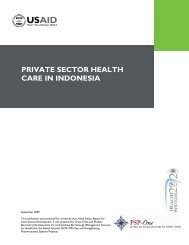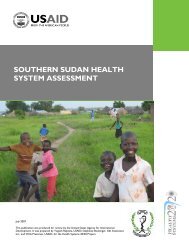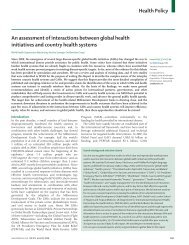Building Health Management Information Systems in Egypt - PHRplus
Building Health Management Information Systems in Egypt - PHRplus
Building Health Management Information Systems in Egypt - PHRplus
Create successful ePaper yourself
Turn your PDF publications into a flip-book with our unique Google optimized e-Paper software.
MIS pyramid. It is important that all four of these units be lead by someone competent and<br />
experienced <strong>in</strong> the appropriate technical areas.<br />
The MIS organization <strong>in</strong> Annex D shows all four units report<strong>in</strong>g to a s<strong>in</strong>gle leader who<br />
reports directly to the chief executive. That person is responsible for overall plann<strong>in</strong>g and<br />
coord<strong>in</strong>ation of the <strong>in</strong>formation system, and must have appropriate technical skills and experience.<br />
It is vital that this person also understand the health sector and the needs of MOHP decisionmakers.<br />
Once this chief <strong>in</strong>formation officer is <strong>in</strong> place, he or she should be charged with sole<br />
responsibility for mak<strong>in</strong>g sure the <strong>in</strong>formation system serves the needs of the M<strong>in</strong>istry. This<br />
should be done through a formal advisory committee of <strong>in</strong>formation consumers, and through<br />
feedback solicited regularly from users. MIS plann<strong>in</strong>g and implementation should not be done by<br />
committee.<br />
5.2.7 Governorate <strong>Health</strong> Directorates<br />
For district level data entry, each district must be provided with the necessary data<br />
process<strong>in</strong>g equipment. The comput<strong>in</strong>g platform must be ma<strong>in</strong>ta<strong>in</strong>ed and provided with<br />
consumable supplies. More importantly, personnel responsible for this operation must be<br />
identified, tra<strong>in</strong>ed, and reta<strong>in</strong>ed.<br />
An <strong>in</strong>creas<strong>in</strong>gly decentralized decision model argues aga<strong>in</strong>st a support system centralized<br />
<strong>in</strong> Cairo. Transportation, communication, and personnel constra<strong>in</strong>ts make this difficult. It is<br />
simply not practical or desirable for MOHP headquarters to provide tra<strong>in</strong><strong>in</strong>g and technical support<br />
to all 232 districts. Variations <strong>in</strong> availability of local technical support and reasonable response<br />
time argue for governorate-level control where possible. Equipment and personnel at the district<br />
level must be tra<strong>in</strong>ed, supported, and susta<strong>in</strong>ed by the governorate health directorate. HIS and<br />
BTS teams have already realized this and are plann<strong>in</strong>g to build capacity at the governorate level.<br />
Each effort to build a hierarchical system has and cont<strong>in</strong>ues to expend resources to build<br />
necessary organizational capacity at governorate, and sometimes district levels. These efforts may<br />
<strong>in</strong>clude reorganization, staff strengthen<strong>in</strong>g, formal tra<strong>in</strong><strong>in</strong>g courses, and <strong>in</strong>formal on-the-job<br />
tra<strong>in</strong><strong>in</strong>g. The approach varies depend<strong>in</strong>g on whether the capacity is built solely for the life of a<br />
project, or built to operate the <strong>in</strong>formation system without project help.<br />
To date, most projects have built capacity dependent on project resources. This is well<br />
known. Obstacles to build<strong>in</strong>g susta<strong>in</strong>ed capacity are enormous. They <strong>in</strong>clude the follow<strong>in</strong>g:<br />
> a history of project-specific, project-dependent <strong>in</strong>formation systems<br />
> <strong>in</strong>sufficient project resources dedicated to organizational development and tra<strong>in</strong><strong>in</strong>g<br />
> demand for <strong>in</strong>formation technology beyond current MOHP carry<strong>in</strong>g capacity<br />
36 <strong>Build<strong>in</strong>g</strong> <strong>Health</strong> <strong>Management</strong> MIS <strong>in</strong> <strong>Egypt</strong>: The Role of Technical Support <strong>in</strong> USAID Program Assistance
















